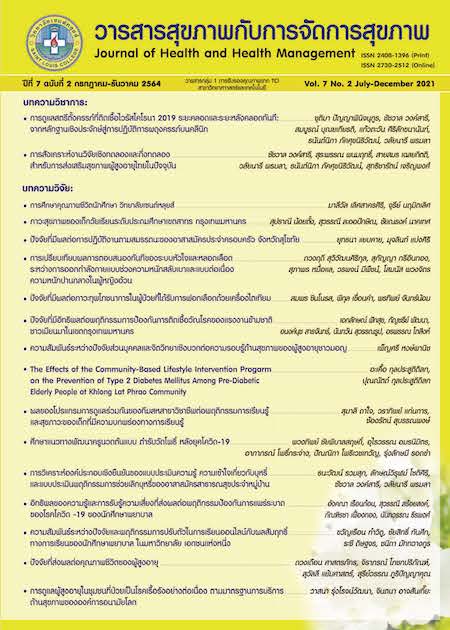Comparisons of Acute Cardiovascular Response Between High Intensity Interval Exercise and Moderate Intensity Continuous Exercise in Obese Females
Keywords:
Obesity, High intensity interval exercise, Moderate intensity continuous exerciseAbstract
This study aims to compare the acute cardiovascular responses between high intensity interval exercise (HIIE) and moderate intensity continuous exercise (MICE) in 15 obese females. A randomized cross-over study was conducted. The participants were randomly assigned to receive 2 types of exercise comprising of (1) HIIE and (2) MICE. Heart rate (HR), systolic blood pressure (SBP), diastolic blood pressure (DBP) and rating of perceived exertion (RPE) were evaluated before and immediately after exercises as well as after exercise at 15, 30, 45 and 60 minutes. The two-way repeated measures ANOVA was employed to analyze the data. This study found that HR immediately after exercise and after exercise at 15, 30, 45 and 60 minutes of HIIE was significantly increased than that of the MICE. HIIE demonstrated a significantly higher RPE immediately after exercise than did the MICE. However, there was no significant difference in SBP and DBP when compared between groups. Moreover, both HIIE and MICE trended to reduce HR and BP similarly to prior exercise. Therefore, HIIE and MICE may be used as an alternative treatment for health promotion in obese females.
References
กระทรวงสาธารณสุข. (2559). แผนพัฒนาสุขภาพ ฉบับที่ 12. Retrieved cited 22 April 2021
Alkahtani, S. A., King, N. A., Hills, A. P., & Byrne, N. M. (2013). Effect of interval training intensity on fat oxidation, blood lactate and the rate of perceived exertion in obese men. Springerplus, 2(1), 1-10.
American college of sport medicine. (2018). ACSM’s Guidelines for Exercise Testing and Prescription. 10th ed. Philadelphia: Lippincott, Williams, & Wilkins.
Baekkerud, F. H., Solberg, F., Leinan, I. M., Wisløff, U., Karlsen, T., & Rognmo, Ø. (2016). Comparison of Three Popular Exercise Modalities on V˙ O2max in Overweight and Obese. Medicine and science in sports and exercise, 48(3), 491-498.
Bonsu, B., & Terblanche, E. (2016). The training and detraining effect of high-intensity interval training on post-exercise hypotension in young overweight/obese women. European journal of applied physiology, 116(1), 77-84.
Castro, E. A., Peinado, A. B., Benito, P. J., Galindo, M., González-Gross, M., Cupeiro, R., & PRONAF Study Group. (2017). What is the most effective exercise protocol to improve cardiovascular fitness in overweight and obese subjects?. Journal of sport and health science, 6(4), 454-461.
Chen, C. Y., & Bonham, A. C. (2010). Postexercise hypotension: central mechanisms. Exercise and sport sciences reviews, 38(3), 122-127.
Cipryan, L., Tschakert, G., & Hofmann, P. (2017). Acute and post-exercise physiological responses to high-intensity interval training in endurance and sprint athletes. Journal of sports science & medicine, 16(2), 219-229.
Dimkpa, U. (2009). Post-exercise heart rate recovery: an index of cardiovascular fitness. Journal of Exercise Physiology online, 12(1), 10-22.
Forjaz, C. L. D. M., Matsudaira, Y., Rodrigues, F. B., Nunes, N., & Negrão, C. E. (1998). Post-exercise changes in blood pressure, heart rate and rate pressure product at different exercise intensities in normotensive humans. Brazilian Journal of Medical and Biological Research, 31(10), 1247-1255.
Halliwill, J. R., Buck, T. M., Lacewell, A. N., & Romero, S. A. (2013). Postexercise hypotension and sustained postexercise vasodilatation: what happens after we exercise?. Experimental physiology, 98(1), 7-18.
Hopps, E., & Caimi, G. (2011). Exercise in obesity management. The Journal of sports medicine and physical fitness, 51(2), 275-282.
Irving, B. A., Rutkowski, J., Brock, D. W., Davis, C. K., Barrett, E. J., Gaesser, G. A., & Weltman, A. (2006). Comparison of Borg-and OMNI -RPE as markers of the blood lactate response to exercise. Medicine and science in sports and exercise, 38(7), 1348-1352.
Jiang, S. Z., Lu, W., Zong, X. F., Ruan, H. Y., & Liu, Y. (2016). Obesity and hypertension. Experimental and therapeutic medicine, 12(4), 2395-2399.
Little, J. P., Gillen, J. B., Percival, M. E., Safdar, A., Tarnopolsky, M. A., Punthakee, Z., ... & Gibala, M. J. (2011). Low-volume high- intensity interval training reduces hyperglycemia and increases muscle mitochondrial capacity in patients with type 2 diabetes. Journal of applied physiology, 111(6), 1554-1560.
MacDonald, J. R. (2002). Potential causes, mechanisms, and implications of post exercise hypotension. Journal of human hypertension, 16(4), 225-236.
Morales-Palomo, F., Ramirez-Jimenez, M., Ortega, J. F., Pallares, J. G., & Mora-Rodriguez, R. (2017). Acute hypotension after high- intensity interval exercise in metabolic syndrome patients. International journal of sports medicine, 38(07), 560-567.
Olney, N., Wertz, T., LaPorta, Z., Mora, A., Serbas, J., & Astorino, T. A. (2018). Comparison of acute physiological and psychological responses between moderate-intensity continuous exercise and three regimes of high-intensity interval training. The Journal of Strength & Conditioning Research, 32(8), 2130-2138.
Plowman, S. A., & Smith, D. L. (2013). Exercise physiology for health fitness and performance. Lippincott Williams: Wilkins
Romero, S. A., McCord, J. L., Ely, M. R., Sieck, D. C., Buck, T. M., Luttrell, M. J., ... & Halliwill, J. R. (2017). Mast cell degranulation and de novo histamine formation contribute to sustained postexercise vasodilation in humans. Journal of Applied Physiology, 122(3), 603-610.
Romero, S. A., Minson, C. T., & Halliwill, J. R. (2017). The cardiovascular system after exercise. Journal of Applied Physiology, 122(4), 925- 932.
Ruangthai, R., & Phoemsapthawee, J. (2019). Combined exercise training improves blood pressure and antioxidant capacity in elderly individuals with hypertension. Journal of Exercise Science & Fitness, 17(2), 67-76.
World Health Organization. (2000). The Asia Pacific perspective: Redefining obesity and its treatment. Retrieved from http://www.wpro.who.int/nutrition/documents/Redefining_obesity/en/.
Downloads
Published
How to Cite
Issue
Section
License
Copyright (c) 2021 Journal of health and health management

This work is licensed under a Creative Commons Attribution-NonCommercial-NoDerivatives 4.0 International License.




